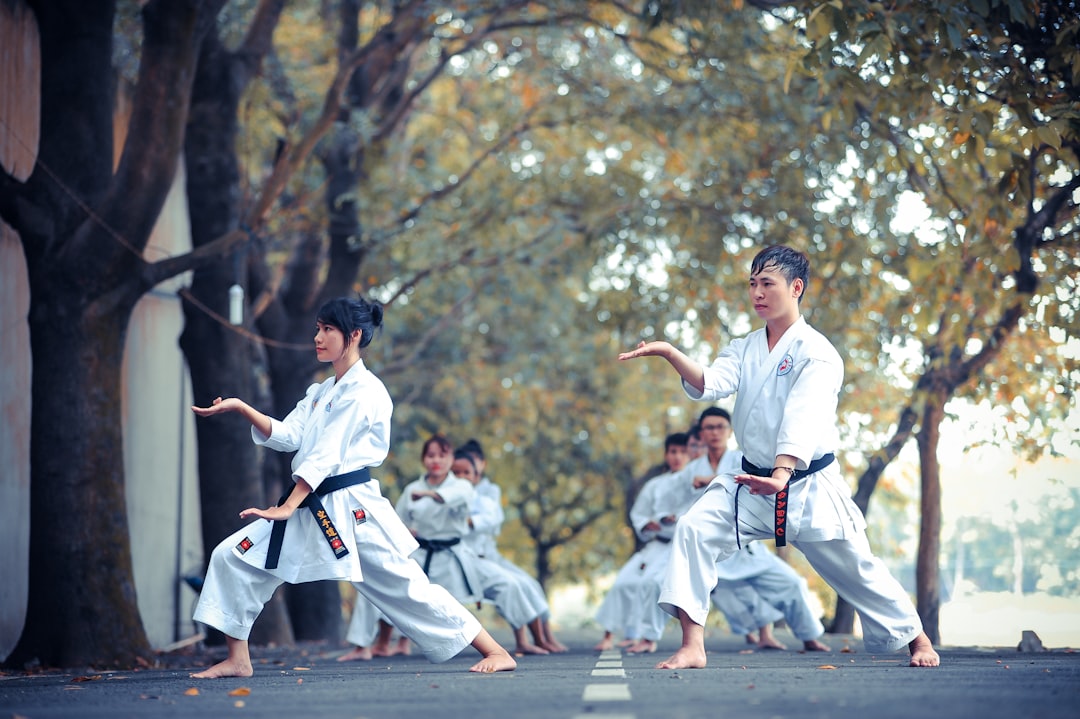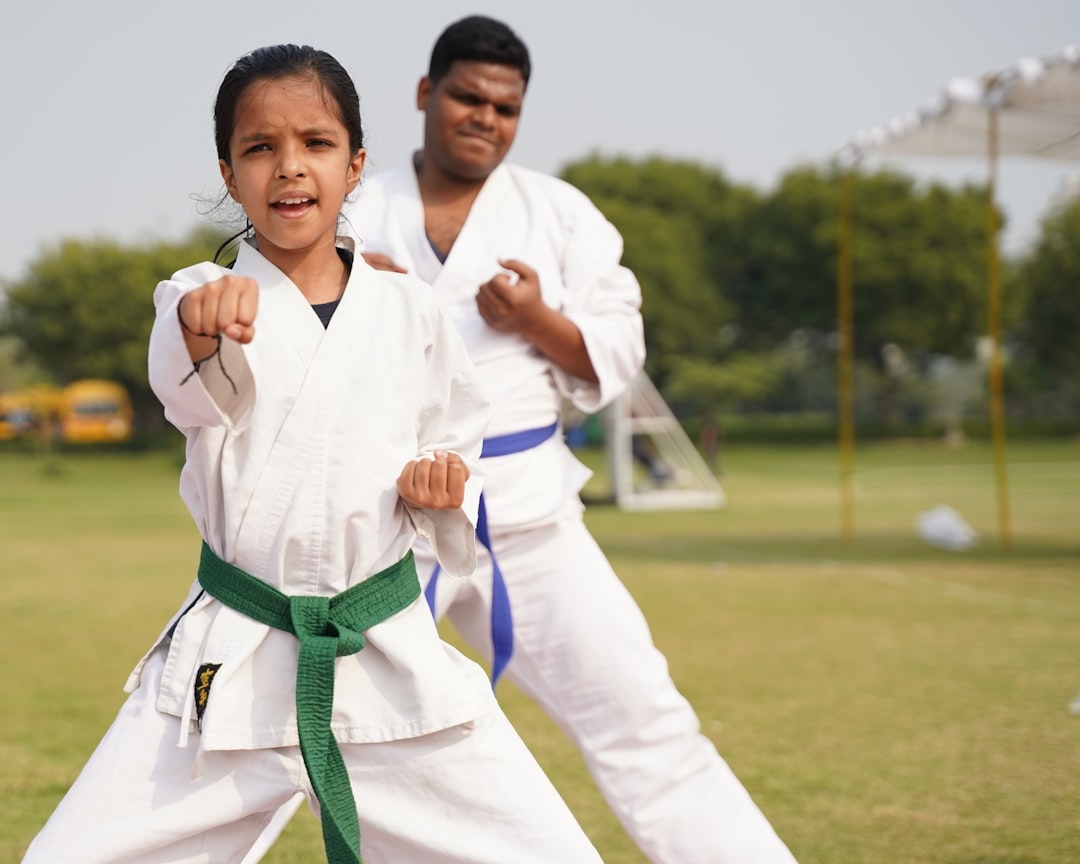Karate practitioners wear the traditional garment, the karate gi, as a uniform and functional element from the outset of their training. The standard gi comprises a uwagi jacket and hakama-style pants or tapering pants, typically white to symbolize purity and humility. The jacket and pants are designed for comfort, mobility, and to minimize hindrance during techniques. Modern gis often use a blend of cotton and polyester for durability and breathability. A well-fitted gi is crucial for unrestricted motion and provides feedback on technique execution, which is vital for skill development. For novices, the gi serves a disciplinary role and allows instructors to assess form, necessitating a snug, breathable fit in solid colors like white or black. Protective gear such as gum shields and hand protectors are essential for sparring, with additional protection like shin guards required for full-contact styles. Advanced practitioners use specialized equipment like keikogi for its optimal range of motion and additional tools like punching bags and focus mitts to enhance technique. The choice of karate suit must align with the specific style and governing body's requirements, ensuring visibility of techniques and compliance with safety standards. Protective gear is indispensable for high-impact sparring or drills, providing both safety and the ability to train with full intensity without injury concerns. In essence, the karate gi and protective gear are integral to safe and effective karate practice, supporting the practitioner's journey from novice to advanced levels.
Embarking on a journey in karate requires more than mere dedication; it demands the right gear to support your practice. This article delves into the essentials every karateka should possess, from the fundamental karate suit known as a Gi to advanced training equipment tailored for serious practitioners. Whether you’re a novice or an experienced martial artist, understanding the necessary gear ensures you’re prepared for each step of your training. Join us as we explore the key components of karate practice, ensuring you’re equipped for success in this dynamic discipline.
- Understanding the Essentials: What Comprises a Karate Suit Called Gi
- Essential Gear for Beginner Karate Practitioners
- Advanced Karate Training Equipment and Accessories
- Specialized Gadgets and Protective Gear for Serious Karateka
Understanding the Essentials: What Comprises a Karate Suit Called Gi

When delving into the realm of karate, one of the first pieces of equipment a practitioner must acquaint themselves with is the karate suit, commonly referred to as a gi. This traditional garment serves not only as a uniform but also as a tool that facilitates proper technique and movement during practice and competition. A standard gi for karate typically consists of a jacket and pants, both of which are traditionally white, symbolizing purity and humility. The jacket, or “uwagi,” is designed to be lightweight and should fit comfortably without being overly restrictive. It buttons up the front and has long sleeves with a hem that can be tied at the wrists for optimal movement during exercises like blocks and strikes. The pants, known as “hakama” in some martial arts, are trousers that taper at the ankles, allowing for ease of movement while maintaining modesty. They are often held up by a belt, which, unlike the colored belts that denote rank in karateka, does not contribute to one’s belt system. The gi is constructed with a blend of cotton and polyester in many cases, offering both durability and breathability. Does the gi’s material and design affect performance? Absolutely. A well-fitted gi allows for unrestricted motion and better feedback on the quality of one’s techniques, which is crucial for both practice and progression in karate. What are the specific features that make a gi suitable for karate training? It must be made of a durable yet breathable fabric, have an appropriate fit to not hinder movement, and be white or another color if specified by the particular style of karate being practiced. Additionally, many modern gis incorporate a ripstop cotton material for increased durability and a reinforced knee area for added protection during sparring sessions. These features ensure that the karateka can execute techniques with precision and confidence.
Essential Gear for Beginner Karate Practitioners

When stepping into the world of karate, beginner practitioners will need a set of essential gear to ensure they can train effectively and safely. A key piece of equipment is the karate suit, also known as a gi. This traditional uniform not only helps students maintain a sense of discipline but also allows instructors to assess form and technique during practice. The gi typically comes in a solid color, such as white or black, and is made of cotton or a cotton-blend fabric for breathability and comfort during vigorous training sessions. It’s important to select a well-fitted gi that allows for full range of motion without being overly baggy, as this can interfere with movements and cause unnecessary strain.
In addition to the karate suit, beginners will also need protective gear. A fundamental piece of protective equipment is the gum shield, which is crucial for protecting the teeth and gums during sparring. Hand protectors are another essential item, as they safeguard the hands from injuries caused by punches and blocks. Depending on the style of karate being practiced, foot protection may also be necessary. For instance, in full-contact styles like Kumite, shin guards and kick protectors are important to prevent injuries to both the attacker and the recipient of techniques. Always ensure that any protective gear you choose is designed for high-impact activities and provides adequate cushioning and support.
Advanced Karate Training Equipment and Accessories

For practitioners looking to elevate their karate training to an advanced level, incorporating specialized equipment and accessories can significantly enhance performance and technique. A key piece of equipment for any serious karateka is the high-quality karate suit, known as a keikogi or dogi. This garment is designed specifically for martial arts practice, offering durability and flexibility that differs from traditional judo gi. It allows for full range of motion while providing the necessary coverage to understand the principles of proper stance and movement. Additionally, advanced karate practitioners often use protective gear such as gum shields, shin guards, and groin protectors to safely practice strikes and kicks without risking injury. These protective items are crucial for maintaining the integrity of forms and techniques under power and with precision.
Beyond the basics, other advanced training equipment can include punching bags, focus mitts, kick shields, and target pads. These tools enable karatekas to practice specific strikes with greater intensity, developing power and accuracy. For instance, a heavy bag is excellent for practicing punching combinations and building core strength, while focus mitts allow a partner to simulate a series of defensive maneuvers, enhancing reaction time and coordination. Furthermore, kick shields are designed to withstand powerful kicks, enabling practitioners to hone their leg techniques safely and effectively. Each piece of advanced training equipment serves a unique purpose in refining skills and ensuring that the karate practice remains dynamic and effective.
Specialized Gadgets and Protective Gear for Serious Karateka

When practicing karate, especially at a competitive or serious level, having the right equipment is paramount for both safety and performance. A karate suit, also known as a gi, is an essential piece of attire for any dedicated karateka. The gi should adhere to specifications that are recognized by your chosen discipline within karate; for instance, a Shotokan practitioner will have different requirements than someone practicing Kyokushin. The fabric should be durable and offer flexibility for full range of motion, while still being heavy enough to allow for a clear view of the techniques executed. Does the gi meet the standards set forth by your karate style’s governing body? It is crucial to ensure that it does, as this will affect both your training and grading progression.
In addition to the karate suit, protective gear plays an important role in serious karate practice. Protective gadgets such as groin guards, hand pads, shin guards, and kick shields are essential for sparring and drills that involve impact. These protect the body from injury during practices or competitions, especially when performing high-impact strikes or receiving them. Are all these protective measures in place to safeguard your training sessions? They not only prevent injuries but also allow karateka to practice with full intensity without compromising their safety or that of their partners. It’s equally important for the protective gear to be well-fitted and comfortable to ensure optimal performance and safety.
In wrapping up our exploration of the multifaceted world of karate, it’s clear that both beginners and seasoned practitioners require a well-equipped arsenal to enhance their training. A high-quality karate suit, known as a gi, serves as the foundation for proper attire, signifying respect for the discipline and providing comfort during practice. As one progresses, additional gear tailored to the intensity of their training becomes paramount. From protective pads to advanced training tools, each piece of equipment is designed to cater to the unique needs of karateka at every level. Whether you’re stepping onto the mat for the first time or honing your skills for competition, the right gear not only supports your technique but also embodies the spirit of karate.
